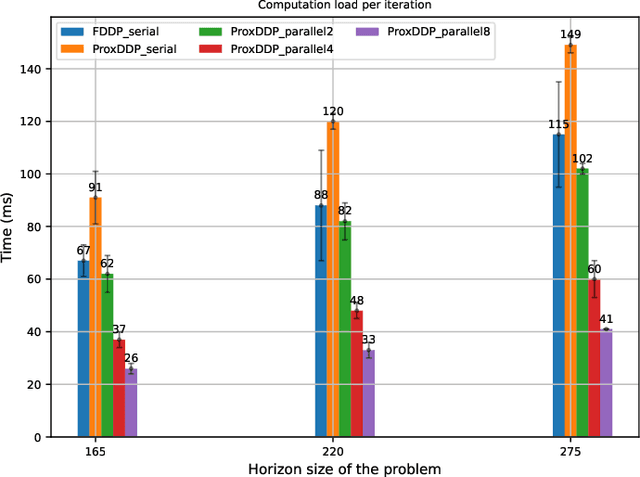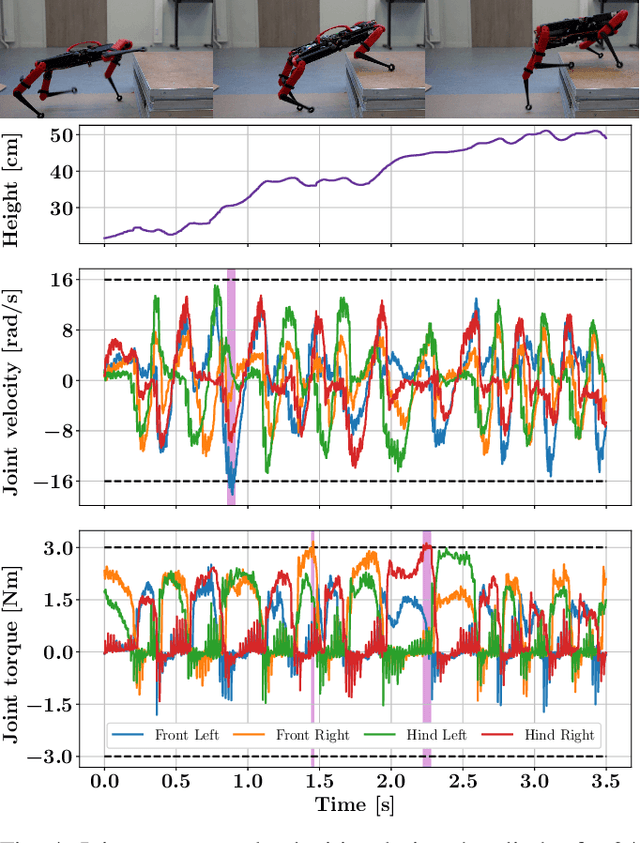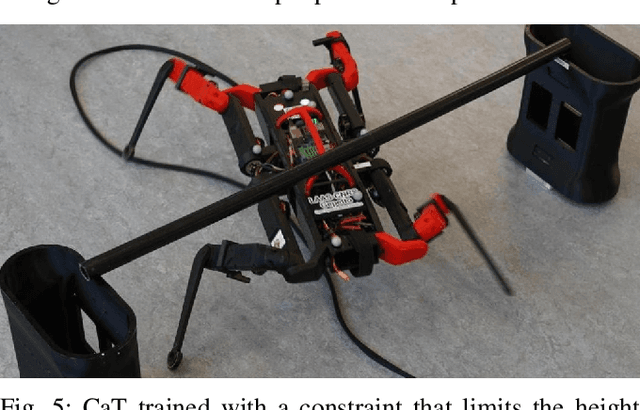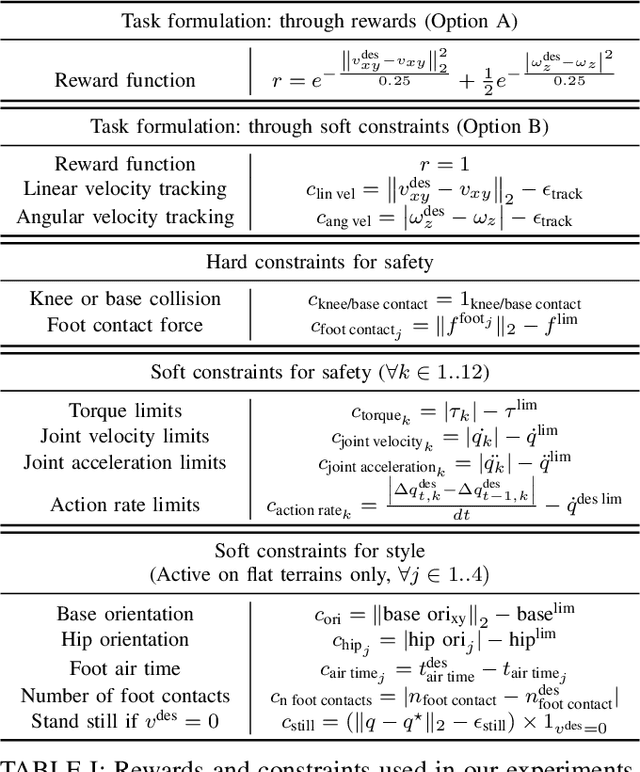Nicolas Mansard
LAAS-GEPETTO, ANITI
Extended URDF: Accounting for parallel mechanism in robot description
Apr 10, 2025Abstract:Robotic designs played an important role in recent advances by providing powerful robots with complex mechanics. Many recent systems rely on parallel actuation to provide lighter limbs and allow more complex motion. However, these emerging architectures fall outside the scope of most used description formats, leading to difficulties when designing, storing, and sharing the models of these systems. This paper introduces an extension to the widely used Unified Robot Description Format (URDF) to support closed-loop kinematic structures. Our approach relies on augmenting URDF with minimal additional information to allow more efficient modeling of complex robotic systems while maintaining compatibility with existing design and simulation frameworks. This method sets the basic requirement for a description format to handle parallel mechanisms efficiently. We demonstrate the applicability of our approach by providing an open-source collection of parallel robots, along with tools for generating and parsing this extended description format. The proposed extension simplifies robot modeling, reduces redundancy, and improves usability for advanced robotic applications.
Optimal Control of Walkers with Parallel Actuation
Apr 01, 2025Abstract:Legged robots with closed-loop kinematic chains are increasingly prevalent due to their increased mobility and efficiency. Yet, most motion generation methods rely on serial-chain approximations, sidestepping their specific constraints and dynamics. This leads to suboptimal motions and limits the adaptability of these methods to diverse kinematic structures. We propose a comprehensive motion generation method that explicitly incorporates closed-loop kinematics and their associated constraints in an optimal control problem, integrating kinematic closure conditions and their analytical derivatives. This allows the solver to leverage the non-linear transmission effects inherent to closed-chain mechanisms, reducing peak actuator efforts and expanding their effective operating range. Unlike previous methods, our framework does not require serial approximations, enabling more accurate and efficient motion strategies. We also are able to generate the motion of more complex robots for which an approximate serial chain does not exist. We validate our approach through simulations and experiments, demonstrating superior performance in complex tasks such as rapid locomotion and stair negotiation. This method enhances the capabilities of current closed-loop robots and broadens the design space for future kinematic architectures.
Control of Humanoid Robots with Parallel Mechanisms using Kinematic Actuation Models
Mar 28, 2025Abstract:Inspired by the mechanical design of Cassie, several recently released humanoid robots are using actuator configuration in which the motor is displaced from the joint location to optimize the leg inertia. This in turn induces a non linearity in the reduction ratio of the transmission which is often neglected when computing the robot motion (e.g. by trajectory optimization or reinforcement learning) and only accounted for at control time. This paper proposes an analytical method to efficiently handle this non-linearity. Using this actuation model, we demonstrate that we can leverage the dynamic abilities of the non-linear transmission while only modeling the inertia of the main serial chain of the leg, without approximating the motor capabilities nor the joint range. Based on analytical inverse kinematics, our method does not need any numerical routines dedicated to the closed-kinematics actuation, hence leading to very efficient computations. Our study focuses on two mechanisms widely used in recent humanoid robots; the four bar knee linkage as well as a parallel 2 DoF ankle mechanism. We integrate these models inside optimization based (DDP) and learning (PPO) control approaches. A comparison of our model against a simplified model that completely neglects closed chains is then shown in simulation.
Infinite-Horizon Value Function Approximation for Model Predictive Control
Feb 10, 2025Abstract:Model Predictive Control has emerged as a popular tool for robots to generate complex motions. However, the real-time requirement has limited the use of hard constraints and large preview horizons, which are necessary to ensure safety and stability. In practice, practitioners have to carefully design cost functions that can imitate an infinite horizon formulation, which is tedious and often results in local minima. In this work, we study how to approximate the infinite horizon value function of constrained optimal control problems with neural networks using value iteration and trajectory optimization. Furthermore, we demonstrate how using this value function approximation as a terminal cost provides global stability to the model predictive controller. The approach is validated on two toy problems and a real-world scenario with online obstacle avoidance on an industrial manipulator where the value function is conditioned to the goal and obstacle.
Reinforcement Learning from Wild Animal Videos
Dec 05, 2024



Abstract:We propose to learn legged robot locomotion skills by watching thousands of wild animal videos from the internet, such as those featured in nature documentaries. Indeed, such videos offer a rich and diverse collection of plausible motion examples, which could inform how robots should move. To achieve this, we introduce Reinforcement Learning from Wild Animal Videos (RLWAV), a method to ground these motions into physical robots. We first train a video classifier on a large-scale animal video dataset to recognize actions from RGB clips of animals in their natural habitats. We then train a multi-skill policy to control a robot in a physics simulator, using the classification score of a third-person camera capturing videos of the robot's movements as a reward for reinforcement learning. Finally, we directly transfer the learned policy to a real quadruped Solo. Remarkably, despite the extreme gap in both domain and embodiment between animals in the wild and robots, our approach enables the policy to learn diverse skills such as walking, jumping, and keeping still, without relying on reference trajectories nor skill-specific rewards.
Parallel and Proximal Linear-Quadratic Methods for Real-Time Constrained Model-Predictive Control
May 15, 2024



Abstract:-Recent strides in model predictive control (MPC)underscore a dependence on numerical advancements to efficientlyand accurately solve large-scale problems. Given the substantialnumber of variables characterizing typical whole-body optimalcontrol (OC) problems -often numbering in the thousands-exploiting the sparse structure of the numerical problem becomescrucial to meet computational demands, typically in the range ofa few milliseconds. A fundamental building block for computingNewton or Sequential Quadratic Programming (SQP) steps indirect optimal control methods involves addressing the linearquadratic regulator (LQR) problem. This paper concentrateson equality-constrained problems featuring implicit systemdynamics and dual regularization, a characteristic found inadvanced interior-point or augmented Lagrangian solvers. Here,we introduce a parallel algorithm designed for solving an LQRproblem with dual regularization. Leveraging a rewriting of theLQR recursion through block elimination, we first enhanced theefficiency of the serial algorithm, then subsequently generalized itto handle parametric problems. This extension enables us to splitdecision variables and solve multiple subproblems concurrently.Our algorithm is implemented in our nonlinear numerical optimalcontrol library ALIGATOR. It showcases improved performanceover previous serial formulations and we validate its efficacy bydeploying it in the model predictive control of a real quadrupedrobot. This paper follows up from our prior work on augmentedLagrangian methods for numerical optimal control with implicitdynamics and constraints.
CaT: Constraints as Terminations for Legged Locomotion Reinforcement Learning
Mar 27, 2024



Abstract:Deep Reinforcement Learning (RL) has demonstrated impressive results in solving complex robotic tasks such as quadruped locomotion. Yet, current solvers fail to produce efficient policies respecting hard constraints. In this work, we advocate for integrating constraints into robot learning and present Constraints as Terminations (CaT), a novel constrained RL algorithm. Departing from classical constrained RL formulations, we reformulate constraints through stochastic terminations during policy learning: any violation of a constraint triggers a probability of terminating potential future rewards the RL agent could attain. We propose an algorithmic approach to this formulation, by minimally modifying widely used off-the-shelf RL algorithms in robot learning (such as Proximal Policy Optimization). Our approach leads to excellent constraint adherence without introducing undue complexity and computational overhead, thus mitigating barriers to broader adoption. Through empirical evaluation on the real quadruped robot Solo crossing challenging obstacles, we demonstrate that CaT provides a compelling solution for incorporating constraints into RL frameworks. Videos and code are available at https://constraints-as-terminations.github.io.
Visually Guided Model Predictive Robot Control via 6D Object Pose Localization and Tracking
Nov 09, 2023



Abstract:The objective of this work is to enable manipulation tasks with respect to the 6D pose of a dynamically moving object using a camera mounted on a robot. Examples include maintaining a constant relative 6D pose of the robot arm with respect to the object, grasping the dynamically moving object, or co-manipulating the object together with a human. Fast and accurate 6D pose estimation is crucial to achieve smooth and stable robot control in such situations. The contributions of this work are three fold. First, we propose a new visual perception module that asynchronously combines accurate learning-based 6D object pose localizer and a high-rate model-based 6D pose tracker. The outcome is a low-latency accurate and temporally consistent 6D object pose estimation from the input video stream at up to 120 Hz. Second, we develop a visually guided robot arm controller that combines the new visual perception module with a torque-based model predictive control algorithm. Asynchronous combination of the visual and robot proprioception signals at their corresponding frequencies results in stable and robust 6D object pose guided robot arm control. Third, we experimentally validate the proposed approach on a challenging 6D pose estimation benchmark and demonstrate 6D object pose-guided control with dynamically moving objects on a real 7 DoF Franka Emika Panda robot.
Perceptive Locomotion through Whole-Body MPC and Optimal Region Selection
May 15, 2023Abstract:Real-time synthesis of legged locomotion maneuvers in challenging industrial settings is still an open problem, requiring simultaneous determination of footsteps locations several steps ahead while generating whole-body motions close to the robot's limits. State estimation and perception errors impose the practical constraint of fast re-planning motions in a model predictive control (MPC) framework. We first observe that the computational limitation of perceptive locomotion pipelines lies in the combinatorics of contact surface selection. Re-planning contact locations on selected surfaces can be accomplished at MPC frequencies (50-100 Hz). Then, whole-body motion generation typically follows a reference trajectory for the robot base to facilitate convergence. We propose removing this constraint to robustly address unforeseen events such as contact slipping, by leveraging a state-of-the-art whole-body MPC (Croccodyl). Our contributions are integrated into a complete framework for perceptive locomotion, validated under diverse terrain conditions, and demonstrated in challenging trials that push the robot's actuation limits, as well as in the ICRA 2023 quadruped challenge simulation.
Optimization-Based Control for Dynamic Legged Robots
Nov 21, 2022



Abstract:In a world designed for legs, quadrupeds, bipeds, and humanoids have the opportunity to impact emerging robotics applications from logistics, to agriculture, to home assistance. The goal of this survey is to cover the recent progress toward these applications that has been driven by model-based optimization for the real-time generation and control of movement. The majority of the research community has converged on the idea of generating locomotion control laws by solving an optimal control problem (OCP) in either a model-based or data-driven manner. However, solving the most general of these problems online remains intractable due to complexities from intermittent unidirectional contacts with the environment, and from the many degrees of freedom of legged robots. This survey covers methods that have been pursued to make these OCPs computationally tractable, with specific focus on how environmental contacts are treated, how the model can be simplified, and how these choices affect the numerical solution methods employed. The survey focuses on model-based optimization, covering its recent use in a stand alone fashion, and suggesting avenues for combination with learning-based formulations to further accelerate progress in this growing field.
 Add to Chrome
Add to Chrome Add to Firefox
Add to Firefox Add to Edge
Add to Edge